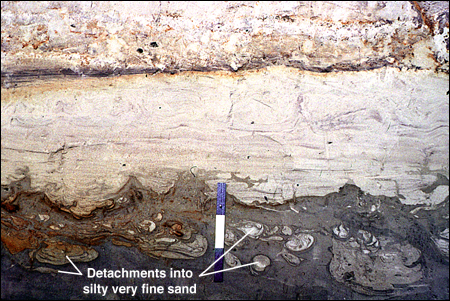

63. White segment of vertical bar is 10
cm long. View is vertical. Pseudonodules of probable seismic origin
have detached from the base of a silt-rich stratum (light colored)
and foundered into a sand deposit (greyish brown). A seismic
origin is deduced here because the pseudonodules have formed by
detachment from the overlying stratum into the sand, in contrast
to the pseudonodules in the previous photograph that formed by
foundering into the clay-rich stratum.
The (plastically deformed) pseudonodules
in this photograph probably formed when the parent silt-rich stratum,
of early Holocene age, was extremely soft and thus very young
(less than several hundred years). (Photograph and interpretations
courtesy of James Vaughn, Missouri Department of Natural Resources.)
A fruitful area for research is to develop criteria for distinguishing the origin (seismic versus nonseismic) for many types of plastic deformations and other types of clastic infillings (including infillings into the top of the host bed). Plastic deformations are plentiful in many field settings worldwide, in which liquefaction features such as the dikes and sills that have been emphasized in this presentation cannot develop because of the absence of liquefiable deposits. Clearly an important part of any criteria for plastic deformations and other infillings must include the regional pattern of size and abundance of the features.
For more information, contact Stephen F. Obermeier